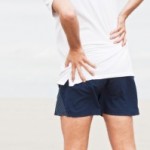Osteoarthritis, also called degenerative arthritis, is joint inflammation that is caused by degeneration of the joints over time. The joint cartilage is worn down, causing friction and swelling of the joint. The hip joint is one common site of osteoarthritis. 
Osteoarthritis often develops in the elderly because the joint cartilage naturally degrades over time. Twenty-five percent of individuals who are 85 have osteoarthritis of the hip joint. While genetic inheritance and other risk factors can have a slight effect on the incidence of hip osteoarthritis, it appears that the lifetime incidence of the condition is about the same, approximately 1 in 4. Unlike other types of arthritis, osteoarthritis is mainly caused by mechanical damage of the joint rather than disease processes. Previous injuries of the hip joint can increase the risk of developing osteoarthritis of the hip.
The symptoms of hip osteoarthritis are pain in the hip joint, thigh, groin or buttocks area. The pain symptoms are typically worse with physical activity and when you first wake up in the morning. Over time, as the joint degenerates, joint stiffness and pain may increase to the point where it hurts while you are resting or with everyday activities. If there is inflammation or formation of bone spurs, it can be difficult to move the affected hip joint. A person may limp when they are walking if they have hip osteoarthritis. Osteoarthritis symptoms usually slowly progress in severity; if the symptoms quickly get worse, there is a chance that a different type of arthritis is causing the symptoms.
Hip osteoarthritis can be diagnosed by a clinical examination of the range of motion of the hip and X-ray images of the hip joints. If a person with hip osteoarthritis gets treatment before the symptoms are severe, conservative treatment measures are usually enough to improve the symptoms. Conservative treatment measures include avoiding activities that will damage the joint, going to physical therapy to help strengthen the joint and improve its range of motion, weight loss if the patient is overweight and the use of over-the-counter non-steroidal anti-inflammatory medications for mild to moderate pain and inflammation. Some people may benefit from walking with a cane to relieve pressure off of the affected hip. If the hip joint is severely damaged from osteoarthritis and the symptoms are not controlled by conservative treatments, hip joint replacement surgery is an option. In this surgical procedure, the hip joint is completely replaced with an artificial hip joint. After recovery and rehabilitation, pain and ability to move the hip joint are greatly improved.
Call us at Non-Surgical Orthopaedics, P.C. for our expertise in treating hip osteoarthritis.
